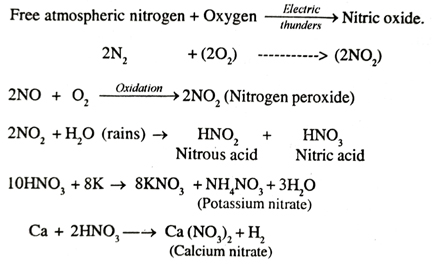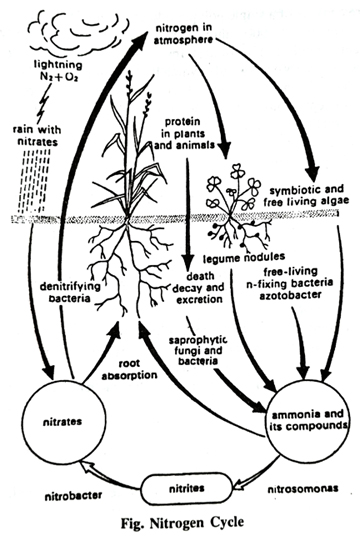Describe the role of microbes (bacteria) in Agriculture.
Q. Describe the role of microbes (bacteria) in Agriculture.
Ans. Nitrogen is the most important and essential mineral element for all living organisms as it is the main constituent part of protein and protoplasm. The main source of nitrogen is atmosphere which contains about 79% free nitrogen but the organisms are unable to use this atmospheric nitrogen directly. Therefore a series of processes are involved into the conversion of atmospheric nitrogen into the form of nitrate in a cyclic order. It is because of the fact that the plants and animals can take nitrogen only in the form of nitrate. The assimilation of atmospheric nitrogen to organic nitrogen is done only by bacteria and other microbes. Thus the bacteria have great importance and lay vital role in nitrogen cycle, which makes nitrogen available to the organisms.
The atmospheric nitrogen combines with hydrogen energy created by electric thunders. As a result the atmospheric nitrogen is converted into nitrate. This nitrate reaches to the soil by rain water and from soil it is absorbed by the plants.

Besides that some atmospheric nitrogen is also converted into nitrate by some marine organisms.
The fixation of atmospheric nitrogen into nitrate is only done by bacteria as stated above. The method of fixation is performed in a stepwise manner, which is given below :
1. Fixation of atmospheric nitrogen by symbiotic bacteria : The most common process of nitrogen fixation is by means of symbiotic bacteria. These bacteria are found in the root nodules of leguminous plant of sub family papillionaceae (Pea family). The common symbiotic bacteria found in root nodules are Rhizobium leguminosearum. They are present in the soil and enter into the root nodules through the root hairs. In root nodules the bacteria live as partial parasite. They grow and multiply there taking nutrition from root nodules of the host plant in one hand and they take free atmospheric nitrogen to synthesize nitrate. They give this nitrate to the plant on the other hand. As the bacteria take food from the host plant and give nitrogen to the host, so the relationship of mutual co-operation is established, which is called reciprocal symbiosis. By this method a good amount of nitrogen is fixed. Therefore the leguminous plants are considered as rich nitrogenous crop. When the crop is harvested the root with their nodules remain in the soil. When these roots and root nodules decayed, their nitrogen becomes available to the soil which makes the soil fertile.
The formation of nitrates through electrochemical and photochemical methods is about 34/2/yr., whereas through biological sources the formation of nitrates is from 140 to 700 mg/m2yr. Thus it is evident that nitrogen fixation takes place both chemically and biologically and that nitrogen reaches to the soil in the form of nitrates through the rains. The terrestrial plants absorb it with the help of root hairs and converts it into protein. This protein is used by men and other animals.
After death the dead bodies of animals get decomposed into water, ammonia, CO2 and nitrogen due to the action of micro-organisms particularly. The process is called ‘Ammonification’. The ammonia on oxidation converts into nitrate. This process is called “Nitrification”. This nitrate mixes with soil and is absorbed by the plants.
2. Denitrification: Some bacteria like Pseudomonas denitrificans reduces the nitrate salts of soil into ammonia. In presence of O, this ammonia produces nitrogen which again goes to the atmosphere. Therefore, the process through which the soil nitrogen returns to atmosphere is called denitrification.
During the course of nitrogen fixation, the contribution of men is also an important factor. A huge amount of waste of agricultural products are thrown to the soil and allowed to decompose which ultimately gives a considerable amount of nitrogen to the soil.
In this way, in nature there is a regular nitrogen cycle in which the atmospheric nitrogen goes to soil. The soil nitrogen is consumed by animals.
After death the dead bodies of animals and plants get decomposed into nitrogen which again goes to the soil.

Follow on Facebook page – Click Here
Google News join in – Click Here
Read More Asia News – Click Here
Read More Sports News – Click Here
Read More Crypto News – Click Here